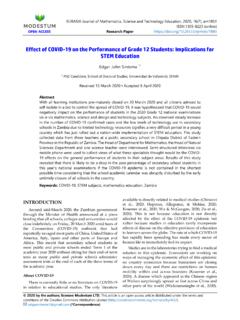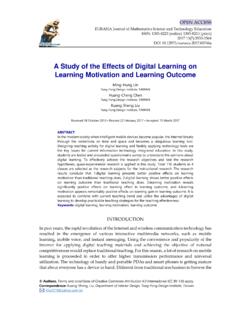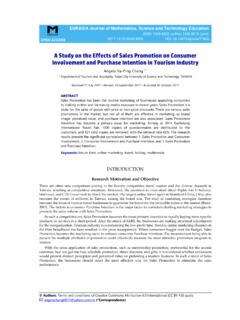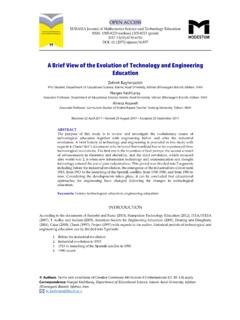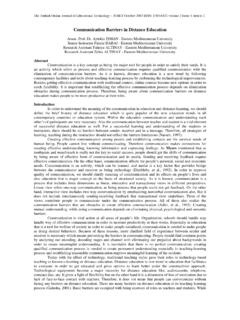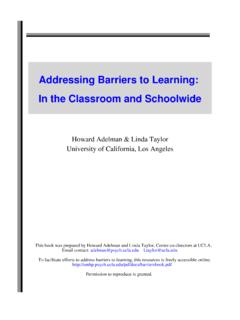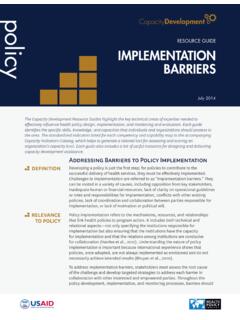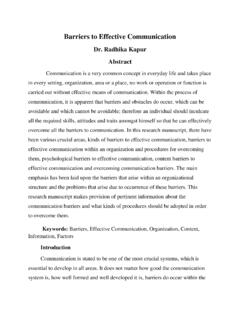Transcription of Barriers to the Successful Integration of ICT in Teaching ...
1 Eurasia Journal of Mathematics, Science & Technology Education, 2009, 5(3), 235-245 Copyright 2009 by EURASIA ISSN: 1305-8223 Barriers to the Successful Integration of ICT in Teaching and Learning Environments: A Review of the Literature Khalid Abdullah Bingimlas RMIT University, Bandoora, VIC, AUSTRALIA Received 17 July 2008; accepted 24 March 2009 The use of ICT in the classroom is very important for providing opportunities for students to learn to operate in an information age. Studying the obstacles to the use of ICT in education may assist educators to overcome these Barriers and become Successful technology adopters in the future. This paper provides a meta-analysis of the relevant literature that aims to present the perceived Barriers to technology Integration in science education.
2 The findings indicate that teachers had a strong desire for to integrate ICT into education; but that, they encountered many Barriers . The major Barriers were lack of confidence, lack of competence, and lack of access to resources. Since confidence, competence and accessibility have been found to be the critical components of technology Integration in schools, ICT resources including software and hardware, effective professional development, sufficient time, and technical support need to be provided to teachers. No one component in itself is sufficient to provide good Teaching . However, the presence of all components increases the possibility of excellent Integration of ICT in learning and Teaching opportunities. Generally, this paper provides information and recommendation to those responsible for the Integration of new technologies into science education.
3 Keywords: Science Teaching , ICT, Integration , Barriers , Professional Development, Review INTRODUCTION Information and communication technology (ICT) has become an important part of most organisations and businesses these days (Zhang & Aikman, 2007). Computers began to be placed in schools in the early 1980s, and several researchers suggest that ICT will be an important part of education for the next generation too (Bransford, Brown, &Cocking, 2000; Grimus, 2000; Yelland, 2001). Modern technology offers many means of improving Teaching and learning in the classroom (Lefebvre, Deaudelin & Loiselle, 2006). Dawes (2001) is of the view that new technologies have the potential to support education across the curriculum and provide opportunities for effective communication between teachers and students in ways that have not been possible before.
4 ICT in education has the potential to be influential in bringing about changes in ways of Teaching . However, this potential may not easily be realised, as Dawes (2001) underlined when he stated that problems arise when teachers are expected to implement changes in what may well be adverse circumstances (p. 61). Due to ICT s importance in society and possibly in the future of education, identifying the possible obstacles to the Integration of these technologies in schools would be an important step in improving the quality of Teaching and learning. Balanskat, Blamire, and Kefala (2006) argue that although educators appear to acknowledge the value of ICT in schools, difficulties Correspondence to: Khalid Abdullah Bingimlas, PhD Student in Science Education School of Education, RMIT University PO Box 71, Bundoora, 3083, VIC, AUSTRALIA E-mail: K.
5 A. Bingimlas 236 2009 EURASIA, Eurasia J. Math. Sci. & Tech. Ed., 5(3), 235-245 continue to be encountered during the processes of adopting these technologies. Many studies have been conducted to investigate Barriers to the Integration of technology in education and in particular in science education (e. g. Al-Alwani, 2005; Gomes, 2005; Osborne & Hennessy, 2003; zden, 2007). This paper provides a meta-analysis of this literature that aims to present the perceived Barriers to technology Integration in science education highlighted in these studies. The purpose of this paper This analysis aims to bring together the findings and key points from a review of a significant part of the available literature associated with teachers Integration of ICT into their Teaching .
6 Studying the obstacles to the use of ICT in learning and Teaching environments is crucial because this knowledge could provide guidance for ways to enhance technology Integration (Schoepp, 2005, p. 2) and encourage greater use of ICT. Identifying the fundamental Barriers may assist teachers and educators to overcome these Barriers and become Successful technology adopters (Al-Alwani, 2005). Based on this analysis, the paper provides recommendations on improving ICT Integration in classrooms. According to Becta (2004), although there is a reasonable amount of research literature on the Barriers to ICT in general, there are few studies that look at Barriers which exist in specific subject areas. Becta (2004) asserts that focusing on the Barriers that particularly affect practitioners in specific roles may be helpful.
7 In response to this suggestion, after briefly reviewing the literature on the place of ICT in education more generally, the paper then provides a general discussion of the relationship between ICT and science education. The importance of ICT in education in the future Several studies argue that the use of new technologies in the classroom is essential for providing opportunities for students to learn to operate in an information age. It is evident, as Yelland (2001) argued, that traditional educational environments do not seem to be suitable for preparing learners to function or be productive in the workplaces of today's society. She claimed that organisations that do not incorporate the use of new technologies in schools cannot seriously claim to prepare their students for life in the twenty-first century.
8 This argument is supported by Grimus (2000), who pointed out that by Teaching ICT skills in primary schools the pupils are prepared to face future developments based on proper understanding (p. 362). Similarly, Bransford et al. (2000) reported that what is now known about learning provides important guidelines for uses of technology that can help students and teachers develop the competencies needed for the twenty-first century (p. 206). ICT can play various roles in learning and Teaching processes. According to Bransford et al. (2000), several studies have reviewed the literature on ICT and learning and have concluded that it has great potential to enhance student achievement and teacher learning. Wong et al.
9 (2006) point out that technology can play a part in supporting face-to-face Teaching and learning in the classroom. Many researchers and theorists assert that the use of computers can help students to become knowledgeable, reduce the amount of direct instruction given to them, and give teachers an opportunity to help those students with particular needs (Iding, Crosby, & Speitel, 2002; Shamatha, Peressini, & Meymaris 2004; Romeo, 2006). While new technologies can help teachers enhance their pedagogical practice, they can also assist students in their learning. According to Grabe and Grabe (2007), technologies can play a role in student skills, motivation, and knowledge. They claim that ICT can be used to present information to students and help them complete learning tasks.
10 According to Becta (2003, p. 10), five factors influence the likelihood that good ICT learning opportunities will develop in schools: ICT resourcing, ICT leadership, ICT Teaching , school leadership, and general Teaching . Becta (2003) also indicated that the success of the Integration of new technology into education varies from curriculum to curriculum, place to place, and class to class, depending on the ways in which it is applied. In science education, there are some areas where ICT has been shown to have a positive impact. The next section discusses this in more detail. Science education and ICT In the past few decades, science curriculum has changed to match the new aims of science education and it will continue to change (Osborne & Hennessy, 2003).


